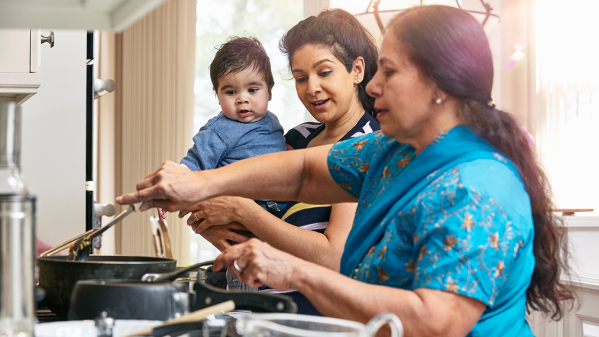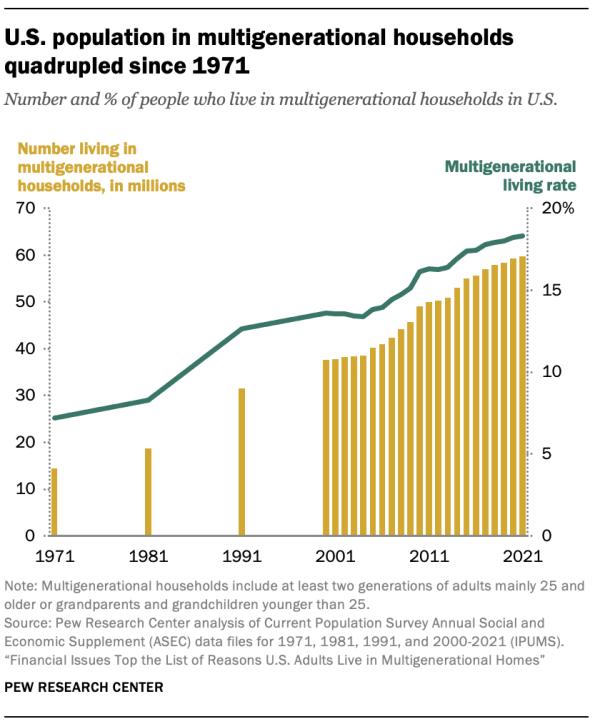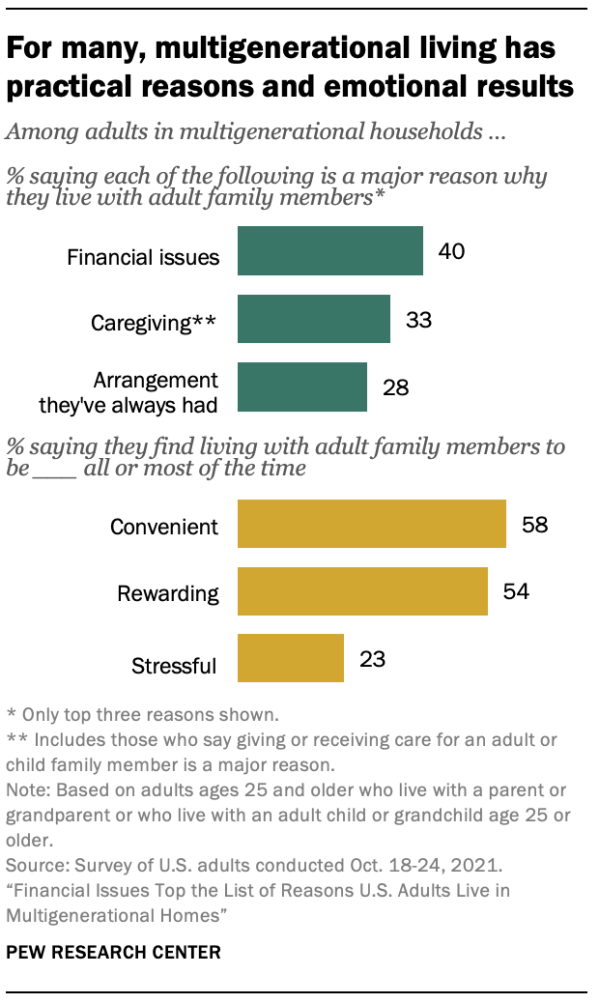Nearly four-in-ten men ages 25 to 29 now live with older relatives
Pew Research Center conducted this study to better understand the experiences of U.S. adults living in multigenerational households, as well as the overall number and share of Americans who live in this type of household. The analysis in this report is based on two separate data sources. The findings about the number and share of Americans in multigenerational households, featured in Chapter 1 of the report, are based on data from the Annual Social and Economic Supplement of the Census Bureau’s Current Population Survey. The findings about the experiences of adults in multigenerational households, featured in Chapter 2 of the report, are based on 1,548 U.S. adults ages 25 and older who live with a parent or grandparent or who live with an adult child or grandchild age 25 or older. The data was collected as a part of a larger survey of 9,676 U.S. adults conducted in October 2021. Everyone who took part is a member of Pew Research Center’s American Trends Panel (ATP), an online survey panel that is recruited through national, random sampling of residential addresses. This way nearly all U.S. adults have a chance of selection. The survey is weighted to be representative of the U.S. adult population by gender, race, ethnicity, partisan affiliation, education and other categories. Read more about the ATP’s methodology.
See here to read more about the questions used for this report and the report’s methodology.
In the analysis of the Annual Social and Economic Supplement of the Census Bureau’s Current Population Survey, multigenerational households are those that include two or more adult generations (mainly ages 25 and older) or a “skipped generation,” which consists of grandparents and their grandchildren younger than 25. See Defining multigenerational households for more detail.
In the analysis of Pew Research Center survey data, adults in multigenerational households include those ages 25 and older who live with a parent or grandparent or who live with an adult child or grandchild age 25 or older.
References to White, Black and Asian Americans include only those who are not Hispanic and identify as only one race. Asian Americans include Pacific Islanders. Hispanics are of any race.
“Middle income” is defined here as two-thirds to double the median annual family income for panelists on the American Trends Panel. “Lower income” falls below that range; “upper income” falls above it. See the methodology for more details.
Multigenerational living has grown sharply in the U.S. over the past five decades and shows no sign of peaking. When asked why they share their home with relatives, Americans often give practical reasons related to finances or family caregiving. But the experience also has an emotional component. About a quarter of adults in multigenerational homes say it is stressful all or most of the time, and more than twice that share say it is mostly or always rewarding.
These experiences with multigenerational living vary by demographic group, especially by age and income, according to a Pew Research Center survey conducted in October 2021. There also are generational differences, especially in terms of stress and money, between the views of adult children and parents who share a home.
According to an analysis of census data from 1971-2021, the number of people living in multigenerational family households quadrupled during that time period, reaching 59.7 million in March 2021. The share more than doubled as well, to 18% of the U.S. population.
This increase in multigenerational living has been fed by social forces that include rapid growth of the U.S. Asian and Hispanic populations who, along with Black Americans, each are more likely than White Americans to live with extended family, especially if they are immigrants. By age, the highest share in this living arrangement is among young adults, a group that compared with prior generations when they were young generally stays in school longer, postpones or forgoes marriage and delays forming their own households. Among young adults ages 25 to 29, nearly a third (31%) live in multigenerational households, often in their parents’ home. Nearly four-in-ten young men in this age group (37%) are in multigenerational households, as are 26% of similarly aged young women.
Living in a multigenerational household appears to confer a financial benefit by buffering residents against poverty, according to census data. Americans living in multigenerational households are less likely to be poor than those living in other types of households. This is especially true of some groups that are economically vulnerable, such as unemployed people.
Although majorities across income groups cite financial issues as a major or minor reason for residing in a multigenerational family household, lower-income adults are more likely to say the living arrangement helps them financially – 50% say it does at least a little, compared with 36% of middle-income adults and 24% of upper-income adults.
Parents living with adult children and adults living with parents are about equally likely to say finances are a major reason for their living arrangement. But among those living with parents, younger adults (ages 25 to 39) are much more likely than older ones (40 and older) to say this (57% to 31%). And while 53% of adult children who live with their parents say it helps them financially at least a little, a smaller share of parents living with an adult child (29%) say the same. Parents are more likely than their adult children to say that living with extended family hurts their finances at least a little.
In exploring the demographics and experiences of Americans in multigenerational households, this report relies on two separate data sources and two definitions of who lives in this type of household.
In reporting the overall number and share of Americans who live in multigenerational households (and the demographic characteristics of these people), the analysis relies on data from the Annual Social and Economic Supplement of the Census Bureau’s Current Population Survey (IPUMS). For this part of the analysis, which is featured in Chapter 1 of the report, multigenerational households are defined as including two or more adult generations or a “skipped generation,” which consists of grandparents and their grandchildren younger than age 25. In this definition, adult children living in a parent’s home must be 25 or older (18- to 24-year-olds living in their parents’ home are not treated as an adult generation). However, 18- to 24-year-olds are treated as an adult generation if they are the householder and a parent or other relative from an older generation lives with them. This arrangement accounts for a relatively small share of multigenerational households. In other households as well, the householder could either be from the older or younger adult generation.
The analysis of census data includes all Americans – children and adults – living in multigenerational households, even if their presence doesn’t make it a multigenerational household. For example, a 7-year-old living with her parents and a grandparent or an 18-year-old living with a 25-year-old sibling and their parents in the parents’ home are each living in a multigenerational household. The trends and patterns here are similar to previous Pew Research Center reports based on the Census Bureau’s American Community Survey, although the Current Population Survey numbers tend to be lower. See Methodology for more detail.
In Chapter 2, we examine the experiences of adults in multigenerational households based on findings from a Pew Research Center survey conducted in October 2021. In this part of the analysis, adults in multigenerational households are defined as those ages 25 and older who live with a parent or grandparent or who live with an adult child or grandchild who is 25 or older (regardless of whether the respondent is or is not the householder).
The nationally representative survey of 9,676 U.S. adults, including 1,548 who live in multigenerational households, was conducted Oct. 18-24, 2021, using the Center’s American Trends Panel. The census figures are from the Annual Social and Economic Supplement of the Census Bureau’s Current Population Survey, which reports data for the civilian population other than those living in institutions such as prisons or mental hospitals.1
Among the other key findings:
A third of U.S. adults in multigenerational households say caregiving is a major reason for their living arrangement, including 25% who cite adult caregiving and 12% who cite child care. Among the other reasons given for living in a multigenerational household, 28% say it’s the arrangement they’ve always had, while smaller shares cite a change in relationship status (15%), or companionship (12%) as a major reason why they live with family members. About one-in-eight adults (13%) say the coronavirus pandemic is a factor in why they live with multiple generations under one roof.
A quarter of adults in multigenerational households say caregiving actually is occurring in their homes, either in the form of personal care for another adult in the household or care for a child younger than 18 who is not the caregiver’s own child. Those with lower (30%) and middle (24%) incomes are more likely than those with upper incomes (15%) to say caregiving is occurring in their household. Among adults living with a parent age 65 and older, 23% say they personally provide care for another adult in the household at least sometimes, compared with 8% of those living with a parent younger than 65.
More adults living in multigenerational households say the experience has been very positive (30%) or somewhat positive (27%) than say it has been somewhat negative (14%) or very negative (3%). An additional 26% say it has been neither. About half or more of those living with adult relatives other than a spouse or partner say it is convenient (58%) or rewarding (54%) all or most of the time. About a quarter (23%) say it is stressful all or most of the time, 40% say it is stressful some of the time and 36% say it is rarely or never stressful.
Among adults younger than 40, men are more likely than women to live in multigenerational households. Among those ages 40 and older, women are more likely to do so. For the most part, the reasons for living in a multigenerational household do not vary between men and women. Women are more likely than men to say a change in relationship status is a major reason. Among those living with a parent, men are more likely than women to say this is the arrangement they’ve always had.
Parents living with an adult child (60%) are more likely than adult children living with a parent (52%) to say their living situation is at least somewhat positive. Among adult children who live with parents, the younger group, ages 25 to 39 (43%), is less likely than those 40 and older (64%) to say the experience is at least somewhat positive. Adults living with parents (31%) are more likely than parents living with adult children (18%) to say their living situation is stressful all or most of the time. Similar shares of adults living with a parent and parents living with an adult child say living in a multigenerational household is convenient or rewarding all or most of the time.
Parents are more likely than adult children to pay the rent or mortgage when the two generations share a home. A majority of parents who live with an adult child (63%) say they pay more than half the rent or mortgage, including 51% who say they pay all. Meanwhile, 30% of adult children living with a parent say they pay nothing. Adult children are more likely to chip in for day-to-day costs; only 9% of those living with their parents say they pay nothing for groceries, utility bills or other household expenses. Still, 45% of parents living with adult children say they pay all such costs.
Upper-income adults are less likely than those with lower or middle incomes to cite caregiving as a reason for living in a multigenerational household. About a third of upper-income adults say that giving or getting adult care is a reason they live in a multigenerational household, compared with 45% of those with middle incomes and 51% of those with lower incomes who say so. Only 9% of upper-income adults identify giving or receiving child care as a reason for living with extended family, compared with 32% of lower-income adults and 20% of middle-income adults.
Upper-income adults in multigenerational households are more likely than those in other income groups to see the arrangement as temporary. Some 47% say they think they are in a temporary situation, compared with 35% of those with middle incomes and 31% of those with lower incomes. Overall, 41% of adults in multigenerational households say their living arrangement is a long-term one, 34% say it is temporary and 24% do not know. Upper-income adults also are more likely to find multigenerational living to be a positive experience – 71% say so, compared with 59% of middle-income adults and 50% of lower-income adults in that situation. Lower-income adults are more likely to say there is not enough space in their home for everyone to live comfortably – 38% say so, compared with 21% of middle-income and just 9% of upper-income residents of multigenerational households.
Among most major racial groups and Hispanics, the share of people in poverty is lower in multigenerational households than in other types of households. Overall poverty is lower in multigenerational homes (10% of those who live in them are poor) compared with other types of households (12%), according to census data. The apparent benefit of living in a multigenerational household extends to people who are unemployed – 11% in multigenerational households were poor in 2020, compared with 19% of those in other living arrangements. Those with a disability that limits or prevents them from working also are less likely to be poor if they live in a multigenerational household (16%) than another type of household (27%).





